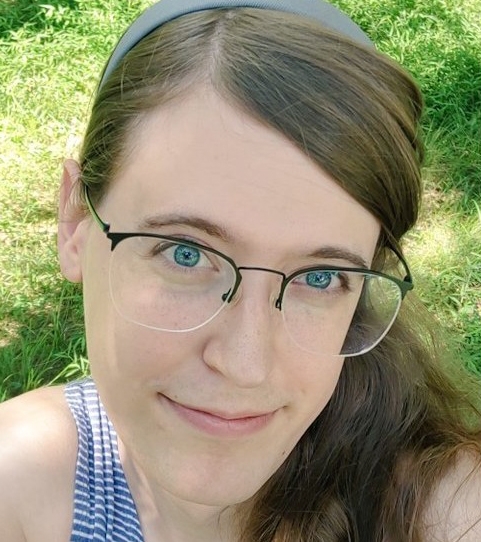
So begins author Chris Alice Kratzer in the preface of her new book, The Social Wasps of North America, published by the company she founded in 2020, Owlfly LLC.
But what she writes is neither true nor what she believes.
Kratzer quickly points out that wasps are "essential, complicated and beautiful."
Indeed, they play important roles in our ecosystems. For one, they provide a beneficial service: natural pest control. Look, ma, no pesticides! Two, they're pollinators.
This book is more than a labor of love. it's a passionate, dedicated look at wasps, written in a conversational tone by a long admirer and supporter of the insects.
Kratzer, who grew up in New Jersey where she continues to live, remembers interacting with insects in her environment, and yes, getting stung multiple times by assorted insects, including wasps. That comes with the territory. Did she become an entomologist? No, she opted to become an engineer. Kratzer received a bachelor of science degree (2019) in mechanical engineering, energy and the environment, from Rochester Institute of Technology. She worked full time as a engineer in New York until May 2020. Today she's the executive director of Owlfly, managing its two divisions, Owlfly Engineering and Owlfly Publishing.
As Kratzer writes on LinkedIn: "I founded Owlfly LLC in 2020 as an opportunity to develop, produce, and market sustainable technologies and publications that demonstrate high potential for climate change mitigation."
Wasps continue to fascinate her and fold her into the Hymenoptera world.
You may want to know why wasps sting, how to avoid the stings, and what to do if you're stung. She tells you.
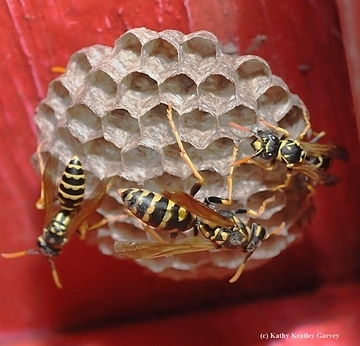
She explains the meaning of inquilines. "An inquiline (also called a cuckoo or social parasite) is an animal that exploits the next of another animal in order to lay its eggs or raise its young."
She writes about prey and food sources. She calls attention to the fact that social wasps "catch and dismember prey with their strong mandibles." And did you know that "their tiny waists prevent them from eating any sold fluids?"
Caterpillars, she says, are "the primary food source for most social wasps." Wasps also "hunt grasshoppers, crickets, katydids, moths, butterflies, beetles, flies, earthworms, lanternflies, cockroaches, smaller wasps, small spiders and cicadas."
There aren't many engineering-trained professionals who write so well and knowledgeably about insects as Kratzer. She began writing her book in 2018, and by January 2020, at age 25, published it. Her path to writing the book included: holing up in the Cornell University Insect Collection; networking with experts; learning how to read taxonomic papers; and teaching herself to write software "to align and compare genetic barcodes.
"I spent close to a thousand hours poring over observations on the community science platform iNaturalist by identifying wasps, mapping ranges and studying color variations," she writes.
The result is this incredible 400-page book, billed as field guide "to all known species of social wasps from the high arctic of Greenland and Alaska to the tropical forests of Panama and Grenada." It covers 208 species in 22 genera, and features some 900 color illustrations. Many of the images are from macro photographers posting to iNaturalist.
Her book brings back memories of Iowa State University Professor Amy Toth's May 2015 seminar on wasps at the UC Davis Department of Entomology and Nematology. Toth told the crowd that wasps are pollinators, they attack pests of agricultural crops, they are extremely intelligent, they are artists, and they are "beautiful, complex and fascinating creatures." She coined the hashtag, #wasplove.
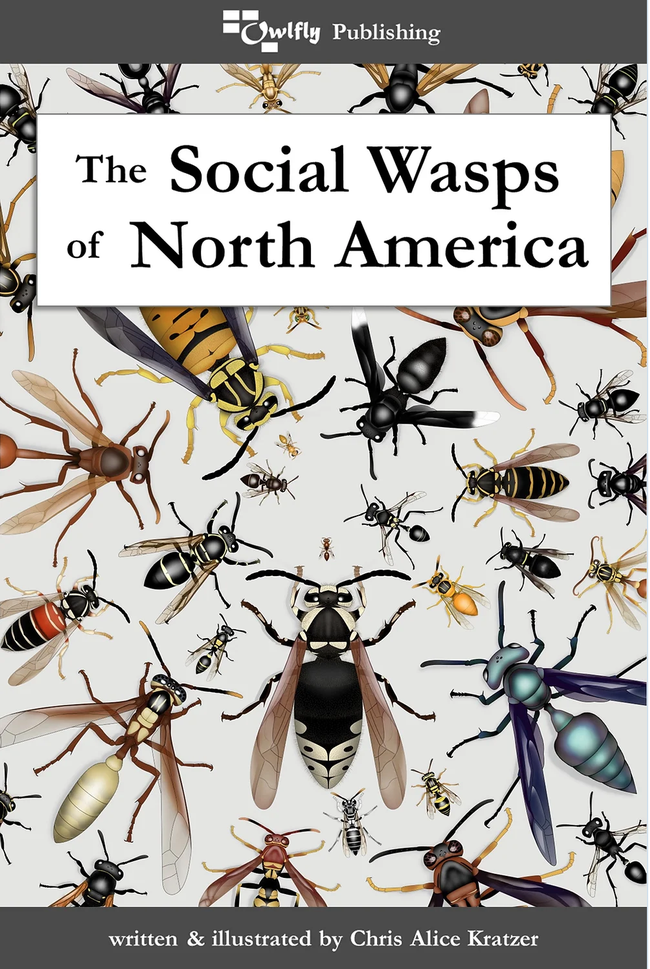
Who knew there are so many species of 'jackets? The one familiar in California is the Western yellowjacket, Vespula pensylvanica.
Kratzer also elaborates on paper wasps. We in California know well the European paper wasp, Polistes dominulo. But did you know its scientific name, dominulo, means "little mistress?" And, as its name implies, it's native to Europe. Introduced in the United States (Massachusetts) in the 1970s, "it has since become a major pest species and one of the most abundant wasps on the continent," she writes.
We remember "Wasp Woman" Lynn Kimsey, director of the Bohart Museum of Entomology and a UC Davis distinguished professor of entomology, telling us about the differences between European paper wasps and Western yellowjackets. (See Bug Squad blog,) "European paper wasps (Polistes dominula) are not scavengers. They only take live insects, particularly caterpillars. Western yellowjackets, Vespula pensylvanica, are serious scavengers..." (Not to mention the fact that the yellowjackets have dark antennae and the paper wasps, orange.)
Note that the UC Statewide Integrated Pest Management Program (UC IPM) provides a wealth of information on Western yellowjackets and paper wasps in its PestNote: "In Western states there are two distinct types of social wasps—yellowjackets and paper wasps. Yellowjackets are by far the most troublesome group, especially ground- and cavity-nesting ones such as the western yellowjacket, which tend to defend their nests vigorously when disturbed. Defensive behavior increases as the season progresses and colony populations become larger while food becomes scarcer. In fall, foraging yellowjackets are primarily scavengers, and they start to show up at picnics and barbecues, around garbage cans, at dishes of dog or cat food placed outside, and where ripe or overripe fruit are accessible. At certain times and places, the number of scavenger wasps can be quite large."
The colorful little tidbits that Kratzer sprinkles throughout her book are intriguing. For instance, the Western yellowjacket is NOT found in Pennsylvania despite its species name, pensylvanica. Someone mislabeled the original specimens. And by the way, its sting is rated 2/5 (painful) on the Schmidt Sting Pain Index.
Bottom line: The Social Wasps of North America is an eye-opener, a page-turner and a mind-boggler that offers a field-guide approach to social wasps. This book belongs in your library whether you're a scientist, a citizen scientist or a curious person who just wants to know about the incredibly diverse social wasps that live in our amazing world.
And, at your next gathering of social (and anti-social) folks, ask if anyone knows the origin of the species name, dominula....
Little mistress!
Attached Images:
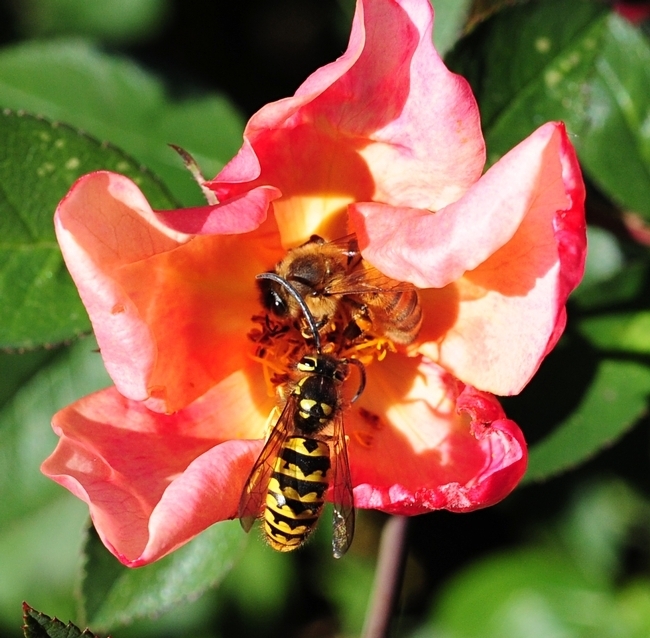
A Western yellowjacket, Vespula pensylvanica, and a honey bee, Apis mellifera) sharing a rose in Davis, Calif. (Photo by Kathy Keatley Garvey)
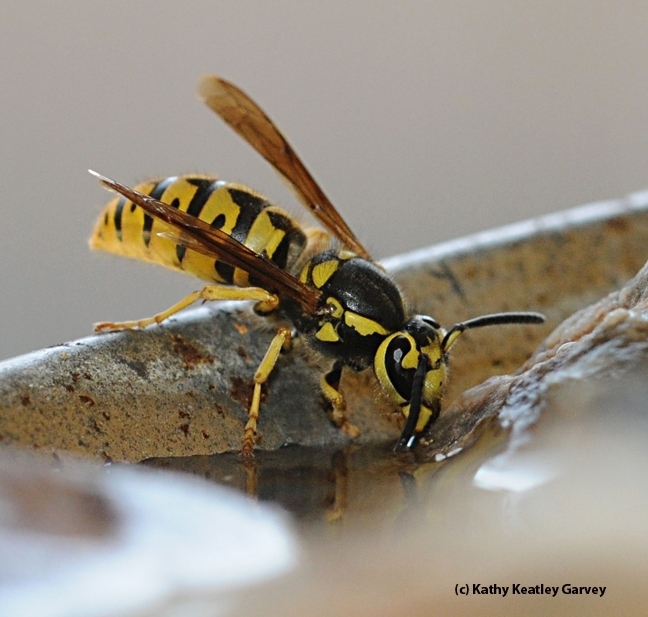
A thirsty Western yellowjacket, Vespula pensylvanica, sipping water from a fountain in Davis, Calif. (Photo by Kathy Keatley Garvey)
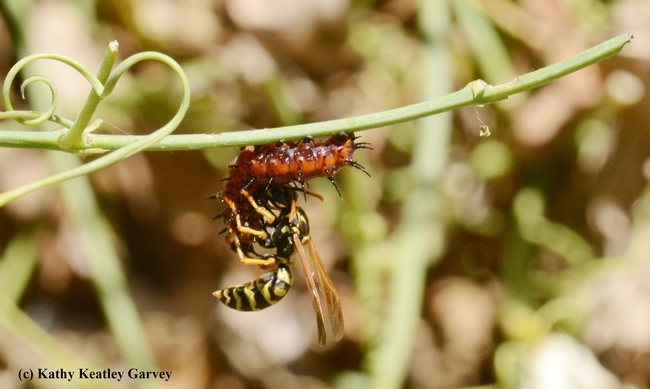
A European paper wasp, Polistes dominulo, preying on a caterpillar of the Gulf Fritillary, Agraulis vanillae, in Vacaville, Calif. (Photo by Kathy Keatley Garvey)
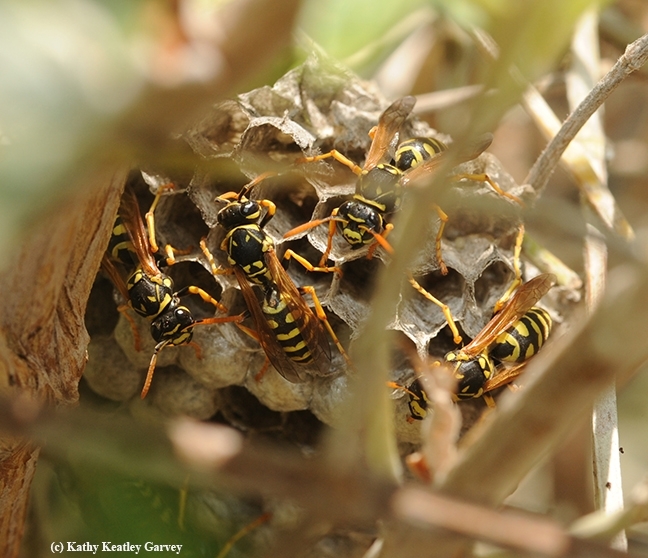
The nest of an European paper wasp, Polistes dominulo, tucked inside a shrub in a garden in Davis, Calif. (Photo by Kathy Keatley Garvey)